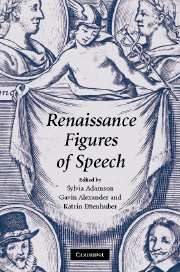Book contents
- Frontmatter
- Dedication
- Contents
- List of illustrations
- List of contributors
- Preface
- Note on spelling and references
- Introduction: the figures in Renaissance theory and practice
- Chapter 1
- Chapter 2
- CHAPTER 2 Compar or parison: measure for measure
- Chapter 3
- Chapter 4
- Chapter 5
- Chapter 6
- Chapter 7
- Chapter 8
- Chapter 9
- Chapter 10
- Chapter 11
- Chapter 12
- Chapter 13
- Notes
- Suggestions for further reading
- Index
CHAPTER 2 - Compar or parison: measure for measure
Published online by Cambridge University Press: 05 February 2014
- Frontmatter
- Dedication
- Contents
- List of illustrations
- List of contributors
- Preface
- Note on spelling and references
- Introduction: the figures in Renaissance theory and practice
- Chapter 1
- Chapter 2
- CHAPTER 2 Compar or parison: measure for measure
- Chapter 3
- Chapter 4
- Chapter 5
- Chapter 6
- Chapter 7
- Chapter 8
- Chapter 9
- Chapter 10
- Chapter 11
- Chapter 12
- Chapter 13
- Notes
- Suggestions for further reading
- Index
Summary
The world is made by Simmetry and proportion, and is in that respect compared to Musick, and Musick to Poetry.
Thomas Campion, Observations in the Art of English PoesyWe live, I regret to say, in an age of surfaces.
Lady Bracknell in The Importance of Being EarnestAssessing attitudes towards artifice is one of the most reliable ways of distinguishing between modern and early-modern culture. The triumph of modernism in the twentieth century brought with it a suspicion of anything ornamental or highly wrought, an aesthetic typified in Mies van der Rohe's famous phrase ‘less is more’ and Adolf Loos's essay ‘Ornament as Crime’. Such a notion would have been incomprehensible to European artists of the Renaissance: in writing, in visual design, in the arts and crafts generally, English people of the sixteenth century favoured objects that were ornamental, ‘curious’, and unabashedly arranged. Artisans and audiences were devoted, in the words of Richard Lanham, to ‘the style which shows’ they did not share Lady Bracknell's regrets.
A taste for equivalence underwrites the highly structured Elizabethan style, and in literary composition the balanced distribution of constituent parts is achieved by means of the rhetorical figure known as compar or parison. Put simply, these terms designate the use of similarly structured phrases or clauses.
- Type
- Chapter
- Information
- Renaissance Figures of Speech , pp. 39 - 58Publisher: Cambridge University PressPrint publication year: 2007
- 4
- Cited by

